RADIUM AGE ART (1907)
By:
March 15, 2024
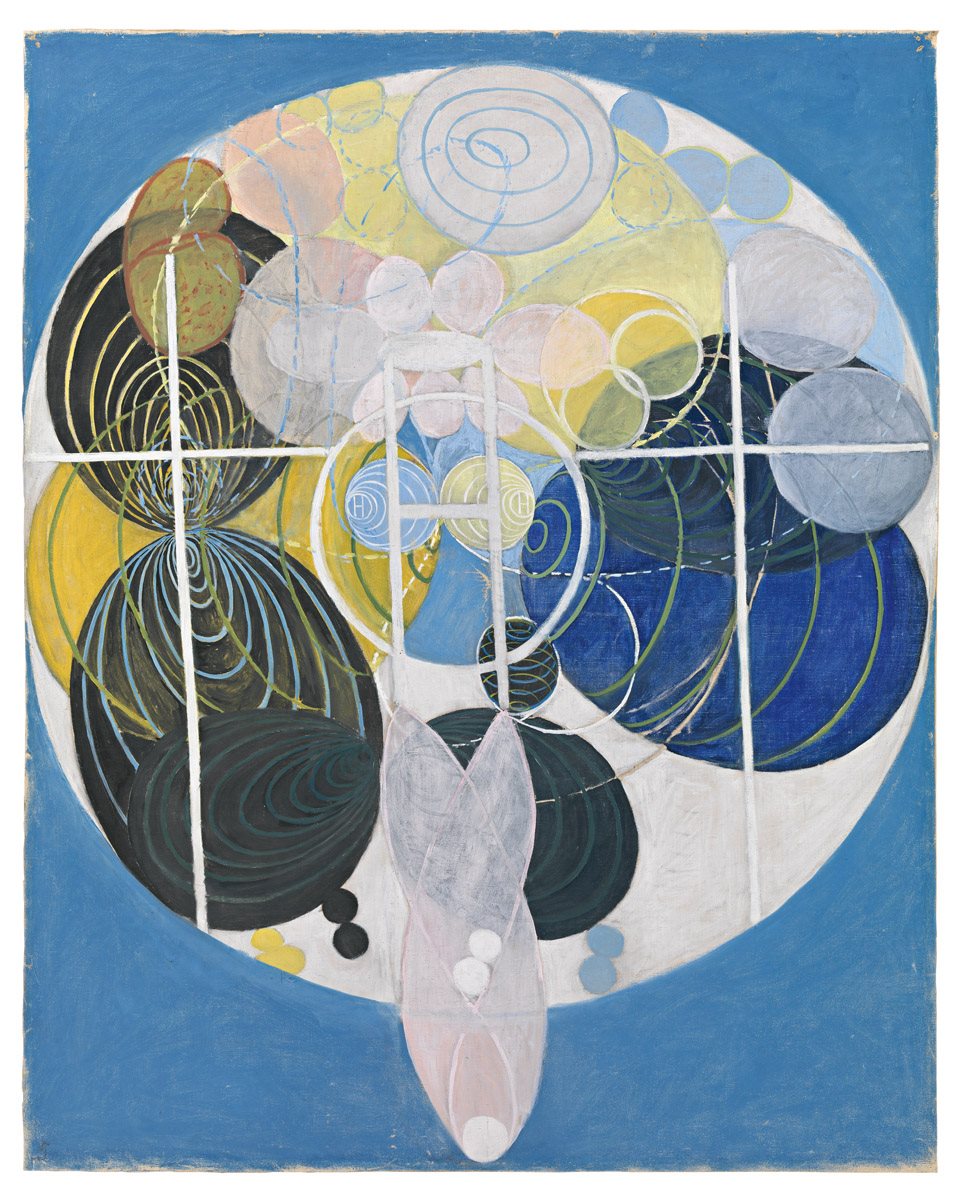
A series of notes regarding proto sf-adjacent artwork created during the sf genre’s emergent Radium Age (1900–1935). Very much a work-in-progress. Curation and categorization by Josh Glenn, whose notes are rough-and-ready — and in some cases, no doubt, improperly attributed. Also see these series: RADIUM AGE TIMELINE and RADIUM AGE POETRY.
RADIUM AGE ART: 1900 | 1901 | 1902 | 1903 | 1904 | 1905 | 1906 | 1907 | 1908 | 1909 | 1910 | 1911 | 1912 | 1913 | 1914 | 1915 | 1916 | 1917 | 1918 | 1919 | 1920 | 1921 | 1922 | 1923 | 1924 | 1925 | 1926 | 1927 | 1928 | 1929 | 1930 | 1931 | 1932 | 1933 | 1934 | 1935.
Between 1907 and 1915 painters in Europe and the USA — Kandinsky, Kupka, Mondrian, Malevich, and later we’d learn about Hilma af Klint; and others — began to create completely abstract works of art.

The 1907 Cézanne memorial exhibition in Paris “helped to loosen the last constraints on artists’ visual imaginations,” writes Denis Thomas is Abstract Painting (1976). Though Cézanne was a legendary figure among members of the Parisian avant-garde, his work was fairly obscure until after his death. The solid forms and architectural structure of Les Grandes Baigneuses (1894–1906) inspired Picasso and Braque. Building on Cézanne’s example, Thomas writes, the Cubists would bring “an analytical attention to the treatment of material objects, representing them in more than one plane and as as presence in space.”
Another influence on Cubism: Picasso’s sketchbooks for Les Demoiselles d’Avignon (1907) illustrate the influence of a 1903 book by Esprit Jouffret, Traité élémentaire de géométrie à quatre dimensions (Elementary Treatise on the Geometry of Four Dimensions), a popularization of Poincaré’s Science and Hypothesis in which Jouffret describes hypercubes and other complex polyhedra in four dimensions and projects them onto the two-dimensional surface.
Working together outside of “The Five,” Hima af Klint and Anna Cassel (see 1906) began to receive messages from the spirit realms asking for their participation in a “special mission.” The Five ceased to meet in 1907. Several of its members went over to collaborate with af Klint for the Paintings for the Temple. “The ensuing visual collaboration resulted in numerous preliminary sketches and twenty-seven small oil paintings executed between October 1906 and September 1907; this is the inaugural series of The Paintings for the Temple and thus a crucial juncture in the history of abstraction. ” — from a 2023 Artforum story on af Klint and Cassel. Later in 1907, af Klint gave up her studio in order to care for her blind, widowed mother and painted nothing — with the exception of a single portrait ‚ until 1912.
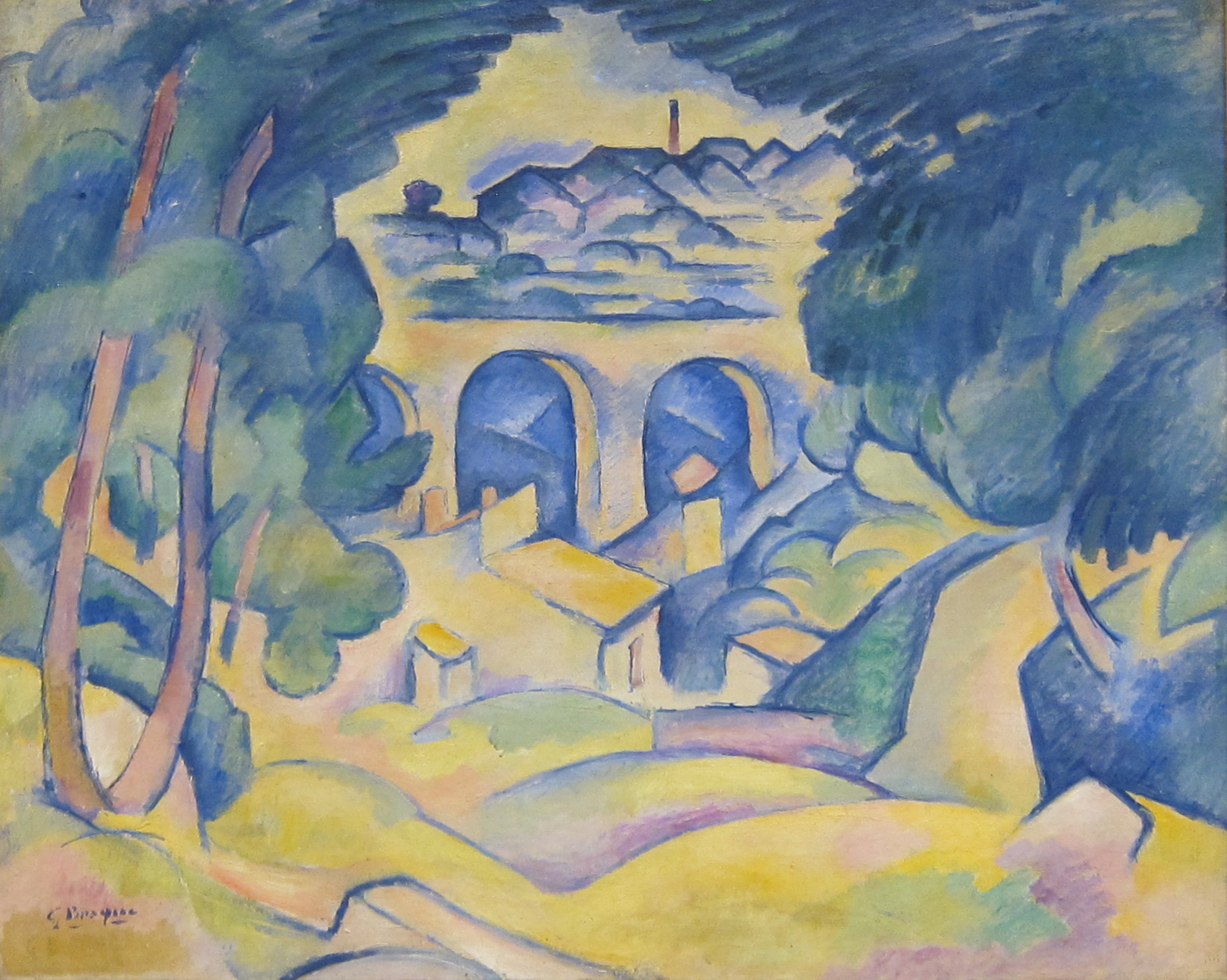
1907’s Salon d’Automne, Paris features Braque’s proto-Cubist work “The Viaduct at L’Estaque” (very much influenced by Cézanne).
Čiurlionis’ paintings of 1907–1909 are wildly innovative. He broke ground with his unique method of abstraction, one based not on color, but on the painting’s graphic-spatial organization of the painting — which supposedly applies “the musical principle.” Another pioneer of abstract art.
In 1907, Aleister Crowley and the occultist Charles Stansfeld Jones determined to found an occult order to act as a successor (one of four such sects) to the Hermetic Order of the Golden Dawn. The result was the A∴A∴, a magical organization dedicated to the advancement of humanity by perfection of the individual on every plane through a graded series of universal initiations.
Schoenberg breaks through to atonality in music in his Second String Quartet (1907).
Alfred Jarry drinks himself to death in 1907.
1907 is a crucial year for Bergsonism and Saussure’s semiotics; see end notes.
See: RADIUM AGE: 1907
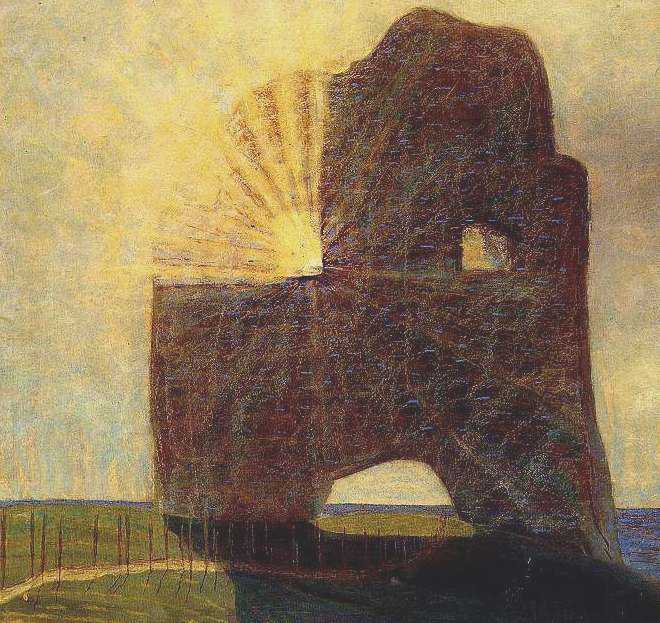
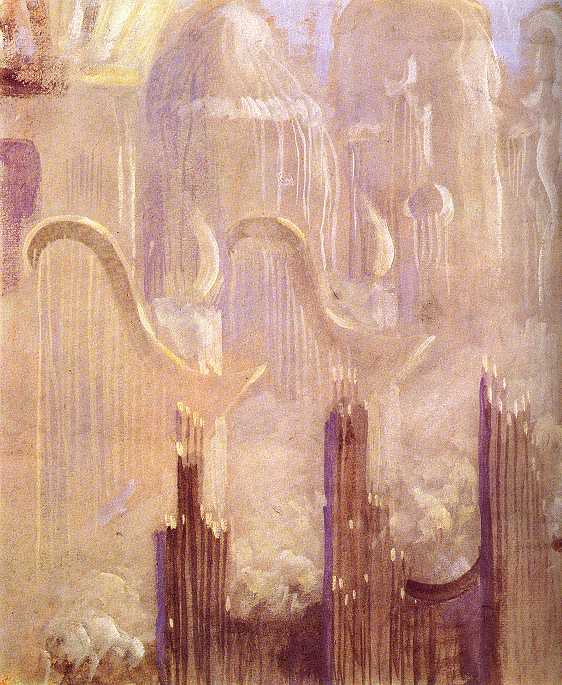
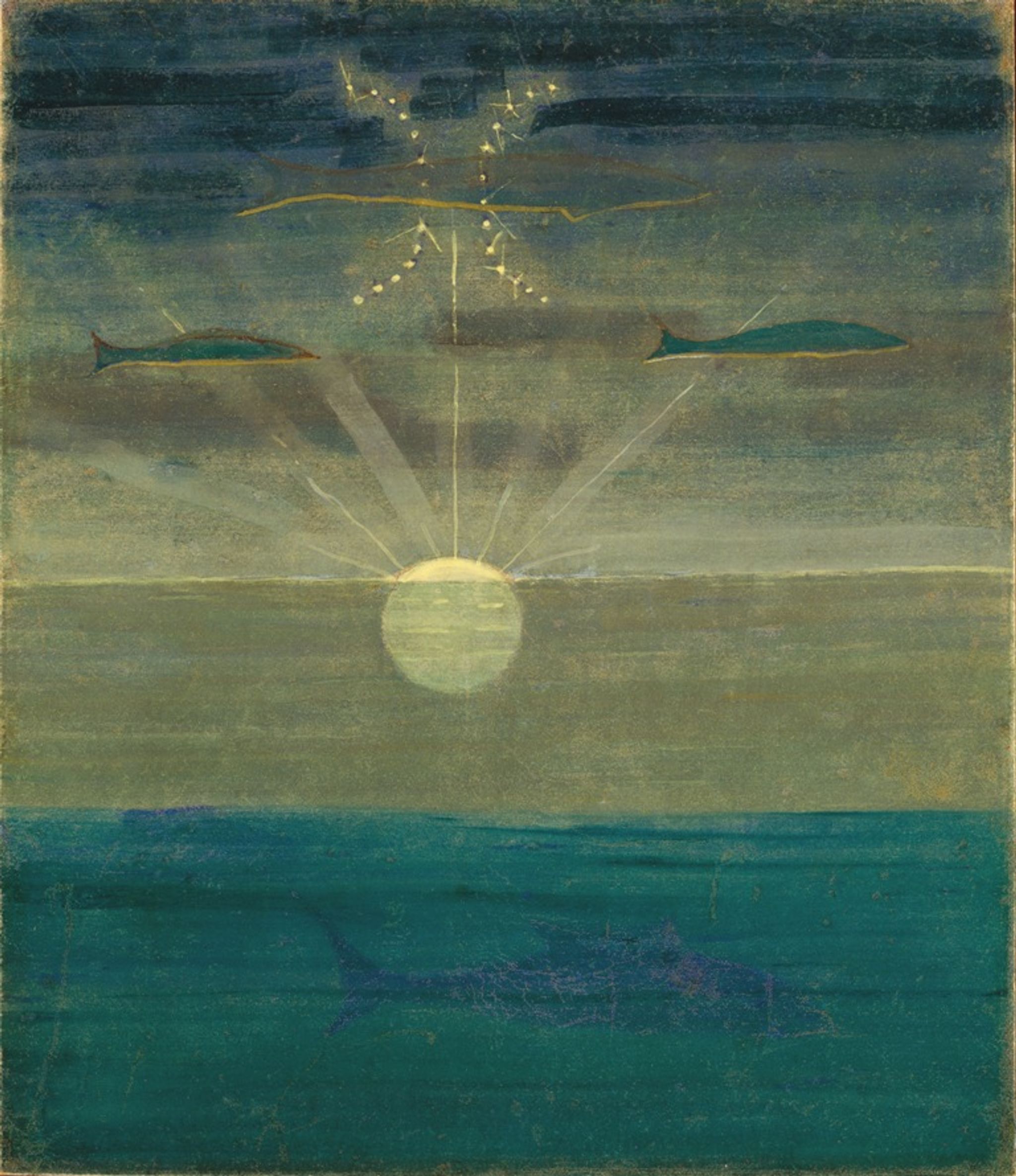
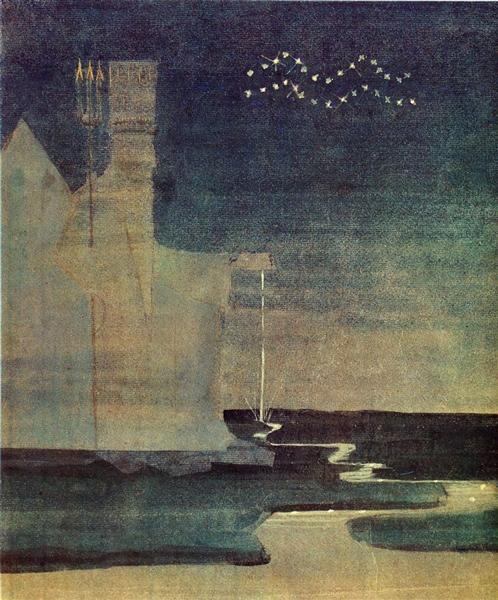
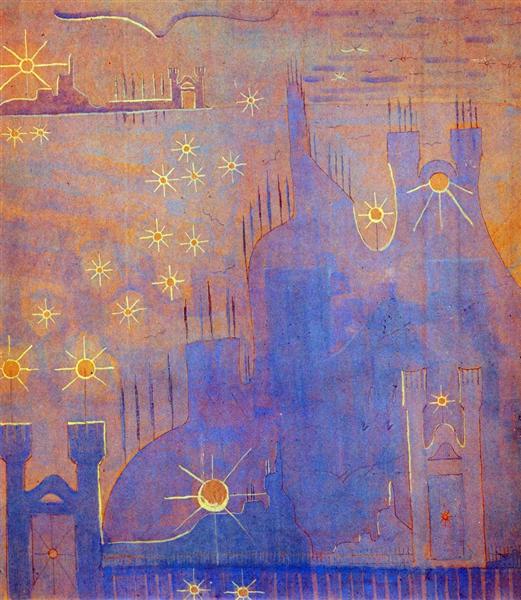

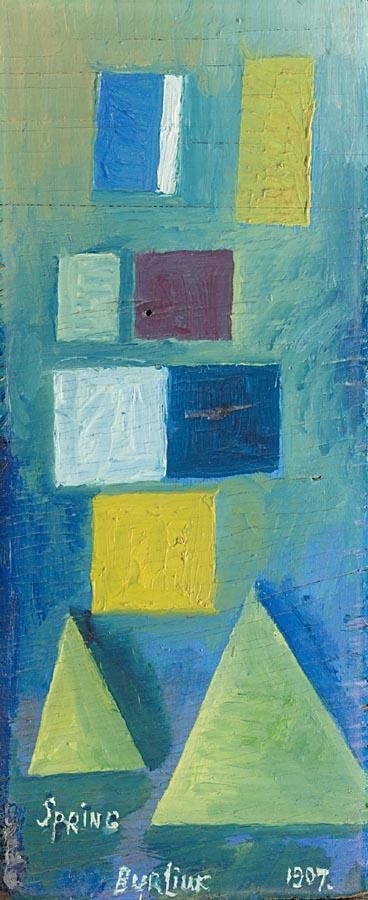
Burliuk was a Ukrainian poet, artist and publicist associated with the Futurist and Neo-Primitivist movements. He has been described as “the father of Russian Futurism.”

The influence of the Fauves (nonnaturalistic colours) and Cézanne (reduction to simple geometric forms of the landscape) can be perceived in the landscapes Braques created in 1907.
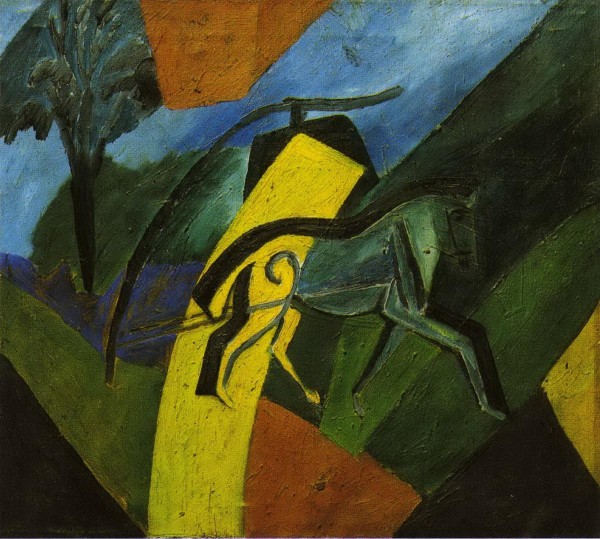
“Horse-Lightning” is a silly title for this painting, in which a wild horse — for Burliuk, a symbol of freedom and mobility — passes between our realistic, 3D dimension (symbolized by the tree) and a 2D dimension — one whose colors and forms are unnatural.

Five nude female prostitutes in a Barcelona brothel. Drawing from tribal primitivism while eschewing Renaissance perspective and verisimilitude. Les Demoiselles was controversial. From October 1906 when he began prep work for Les Demoiselles, until its completion in March 1907, Picasso was vying with Matisse to be perceived as the leader of Modern painting. Upon its completion the painting — an assault upon the tradition of European painting from which Matisse’s controversial Le bonheur de vivre (1905–1906) was derived — would propel Picasso into the center of controversy. (Matisse would remain outside of the various groups that advanced the Abstract cause. Later he’d say of the Cubists, “There was perhaps a concordance between my work and theirs. But perhaps they were trying to find me.”)
Hilton Kramer’s The Triumph of Modernism: “Picasso had turned to an alien tradition of primitive art to create in Les Demoiselles a netherworld of strange gods and violent emotions.”
The apocalyptic power of Les Demoiselles is something Picasso picked up from El Greco’s 1897 painting Opening of the Fifth Seal.
“The Demoiselles is generally referred to as the first Cubist picture. This is an exaggeration, for although it was a major first step towards Cubism it is not yet Cubist. The disruptive, expressionist element in it is even contrary to the spirit of Cubism, which looked at the world in a detached, realistic spirit. Nevertheless, the Demoiselles is the logical picture to take as the starting point for Cubism, because it marks the birth of a new pictorial idiom, because in it Picasso violently overturned established conventions and because all that followed grew out of it.” — Douglas Cooper, The Cubist Epoch
A 1903 book by Esprit Jouffret, Traité élémentaire de géométrie à quatre dimensions (Elementary Treatise on the Geometry of Four Dimensions), a popularization of Poincaré’s Science and Hypothesis, in which Jouffret described hypercubes and other complex polyhedra in four dimensions and projected them onto the two-dimensional surface, would shortly become influential on the development of Cubism. Maurice Princet, a French mathematician and actuary, introduced Poincaré’s work and the concept of the fourth dimension to Pablo Picasso, Guillaume Apollinaire, Max Jacob, Jean Metzinger, Robert Delaunay, Juan Gris and later Marcel Duchamp. He’d become known as “le mathématicien du cubisme” (“the mathematician of cubism”). Picasso’s sketchbooks for Les Demoiselles d’Avignon (1907) illustrate Jouffret’s influence on the artist’s work.
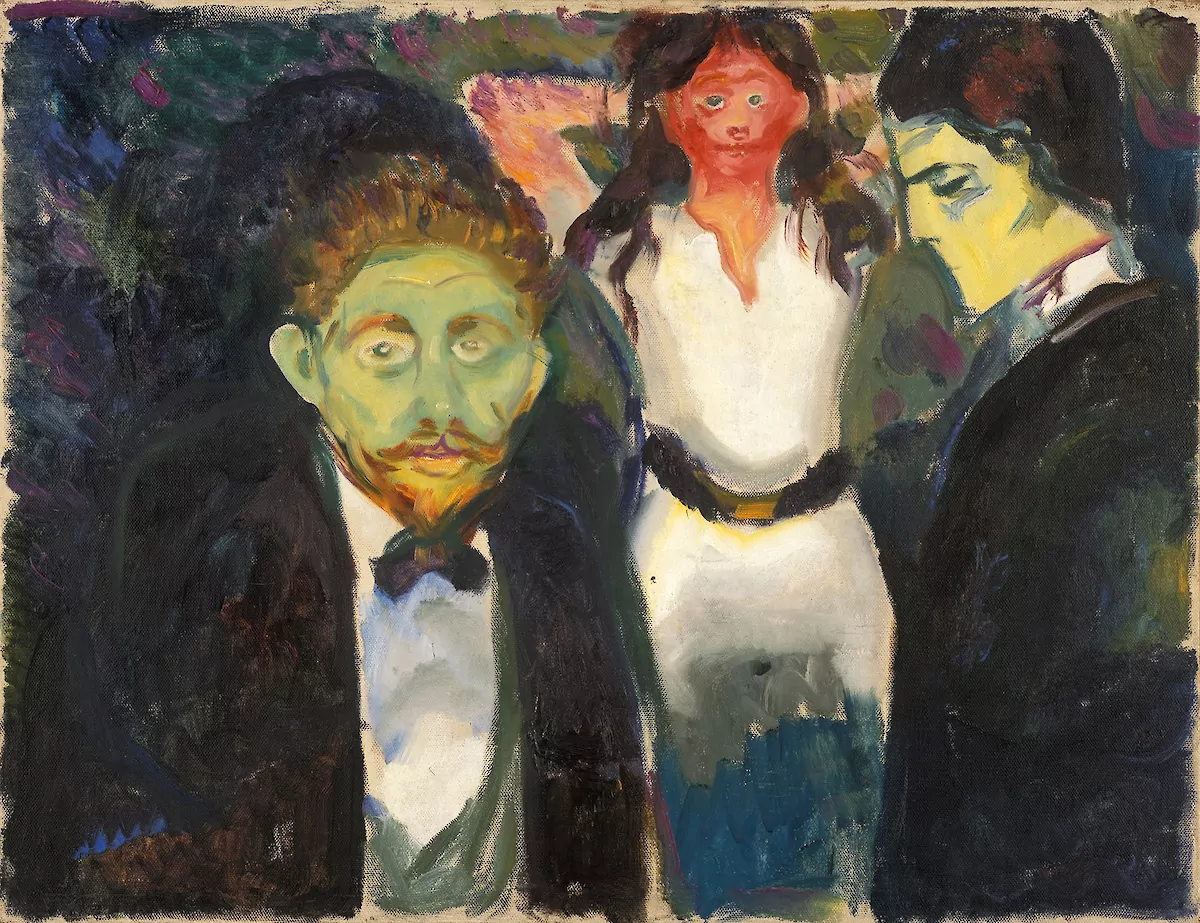
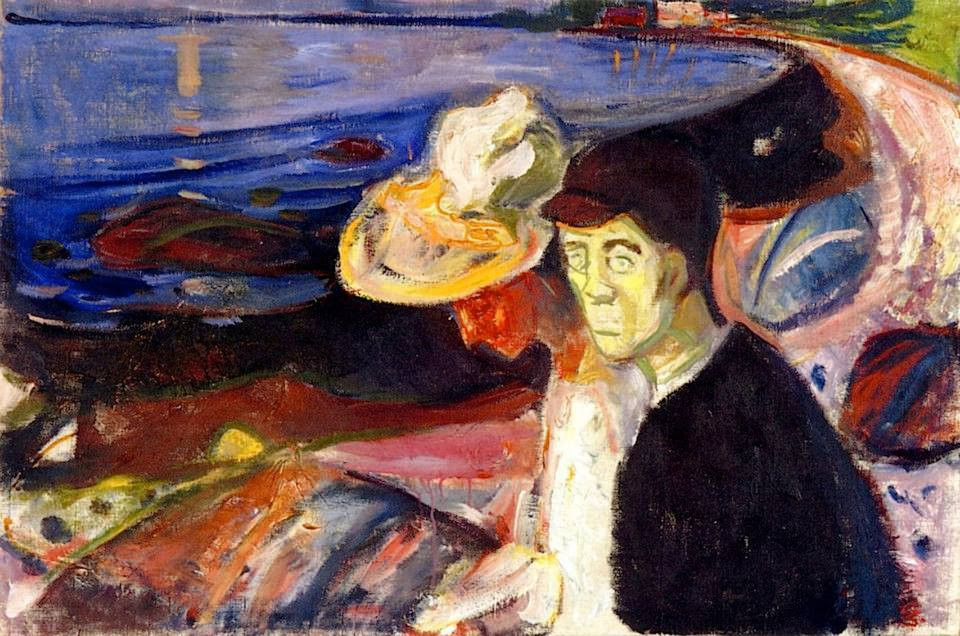
In Man and Woman on the Beach (1907), Edvard Munch’s discordant colours and steep perspective portray a Norwegian beach as a soul in turmoil. By way of comparison, here’s another 1907 man and woman on the beach:
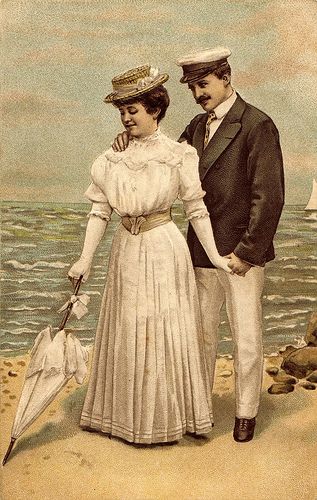

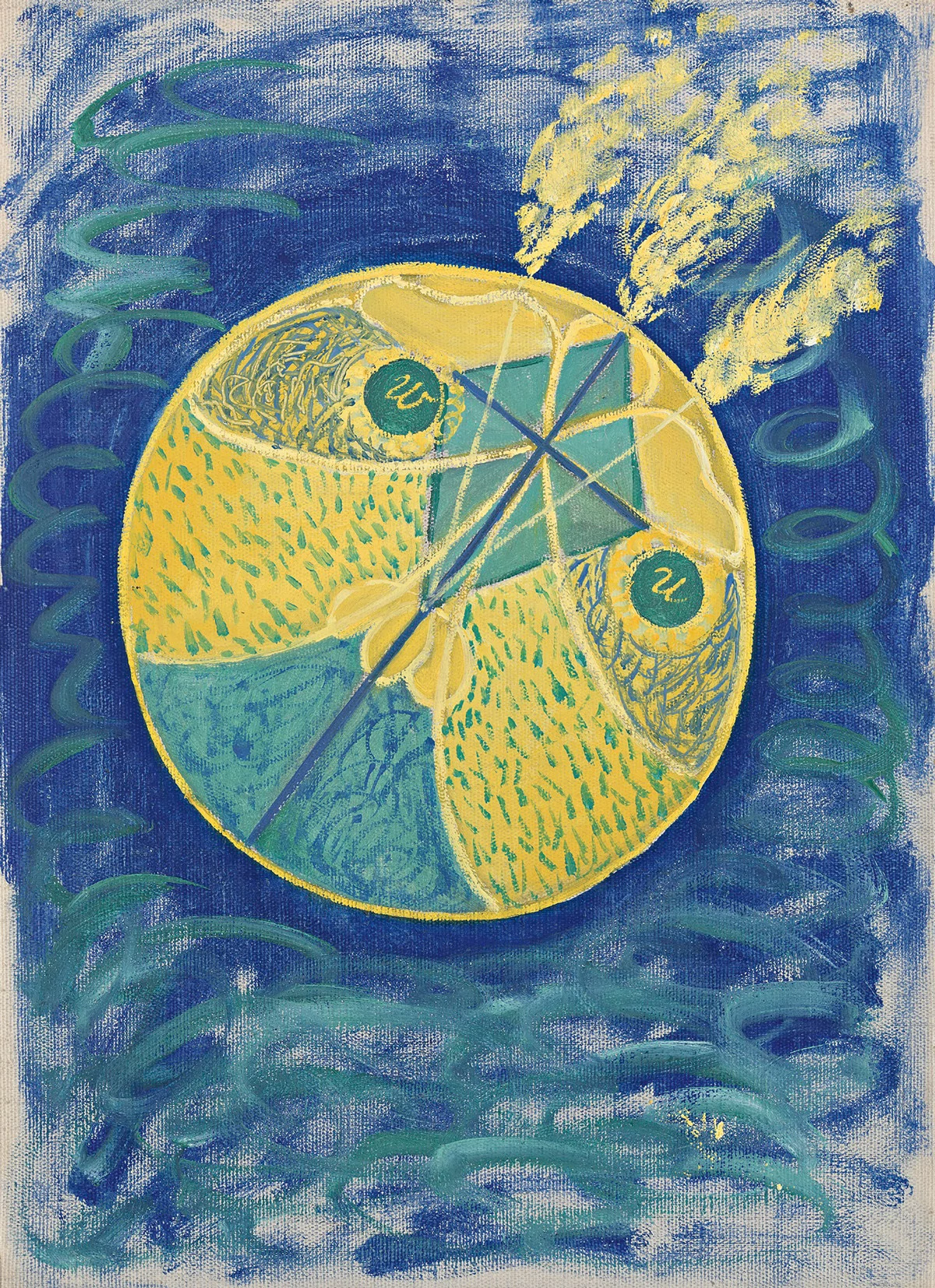
Af Klint began work on her spirit commission in 1906. Between November and the following March, she (and her comrades) produced a series of 26 small-scale oil paintings titled “Primordial Chaos.” These canvases served as preliminary sketches for a body of work that would occupy Af Klint (and her comrades) until 1915. By the time they had finished, these Paintings for the Temple comprised 193 works depicting a vast cosmology.
An essay by Amy Sherlock at the Royal Academy of Art website suggests: “Five years before Kandinsky claimed to have made the first abstract painting, Af Klint’s works — made in near-complete isolation — uncannily anticipate his statement, made in 1912 in Concerning the Spiritual in Art, that painting must communicate ‘the internal truth that only art can divine, which only art can express by those means of expression which are hers alone.'”
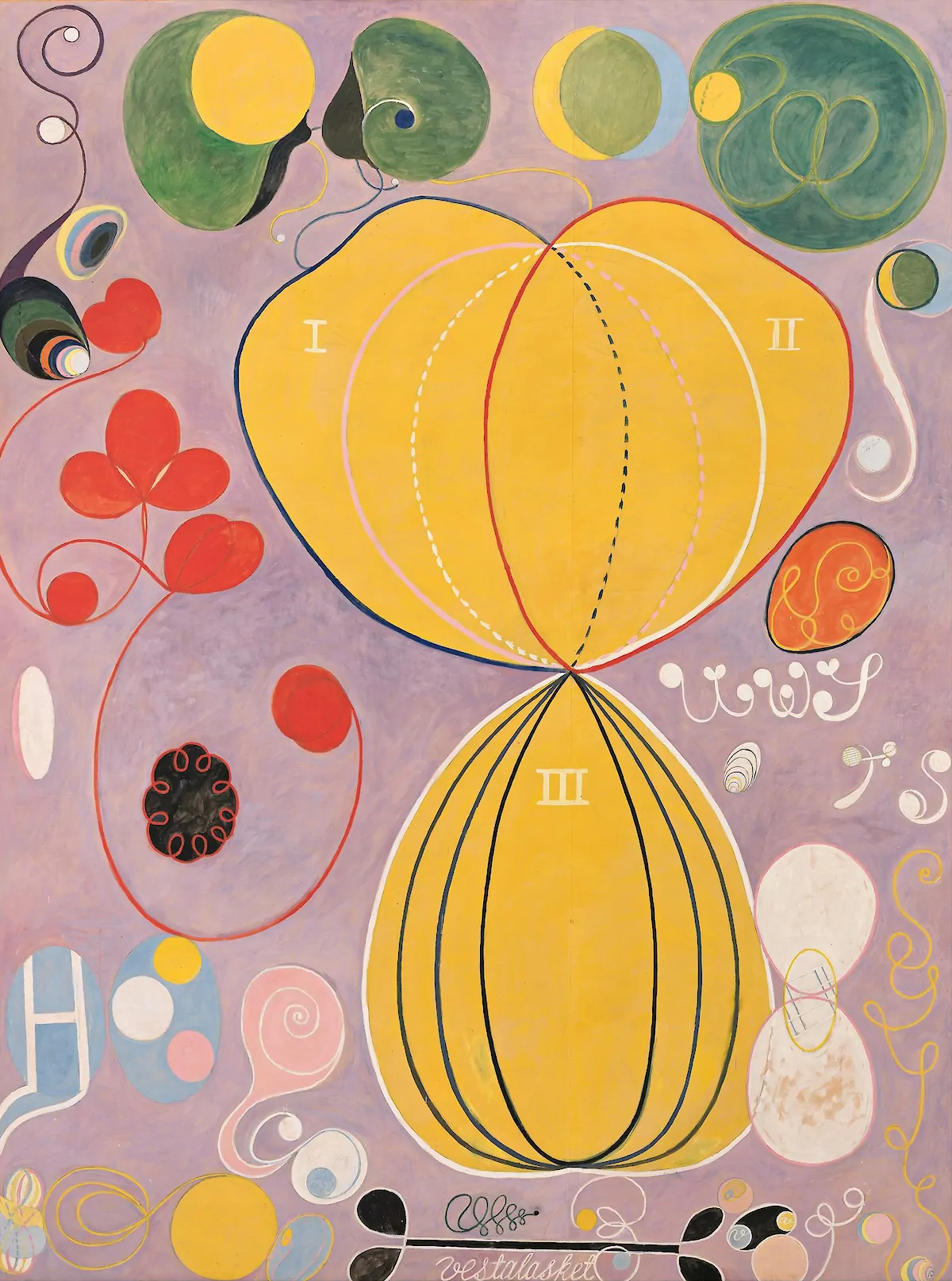
In August 1907, after the completion of the Primordial Chaos sequence, Af Klint (and comrades?) began work on the monumental series on paper “The Ten Largest,” which charts the four ages of man. Description from Amy Sherlock’ Royal Academy of Art essay: “Snail-shell spirals, concentric circles and zygote-like forms nestle amongst coiled fronds and splayed petals (she also produced intricate botanical drawings), all dancing against radiant tempera backgrounds from terracotta orange to faded lilac. Forms bulge, overlap, conjoin in what an eye informed by contemporary science might liken to celestial bodies or cell mitosis; they are extraordinary pictures, immense and ecstatic.”
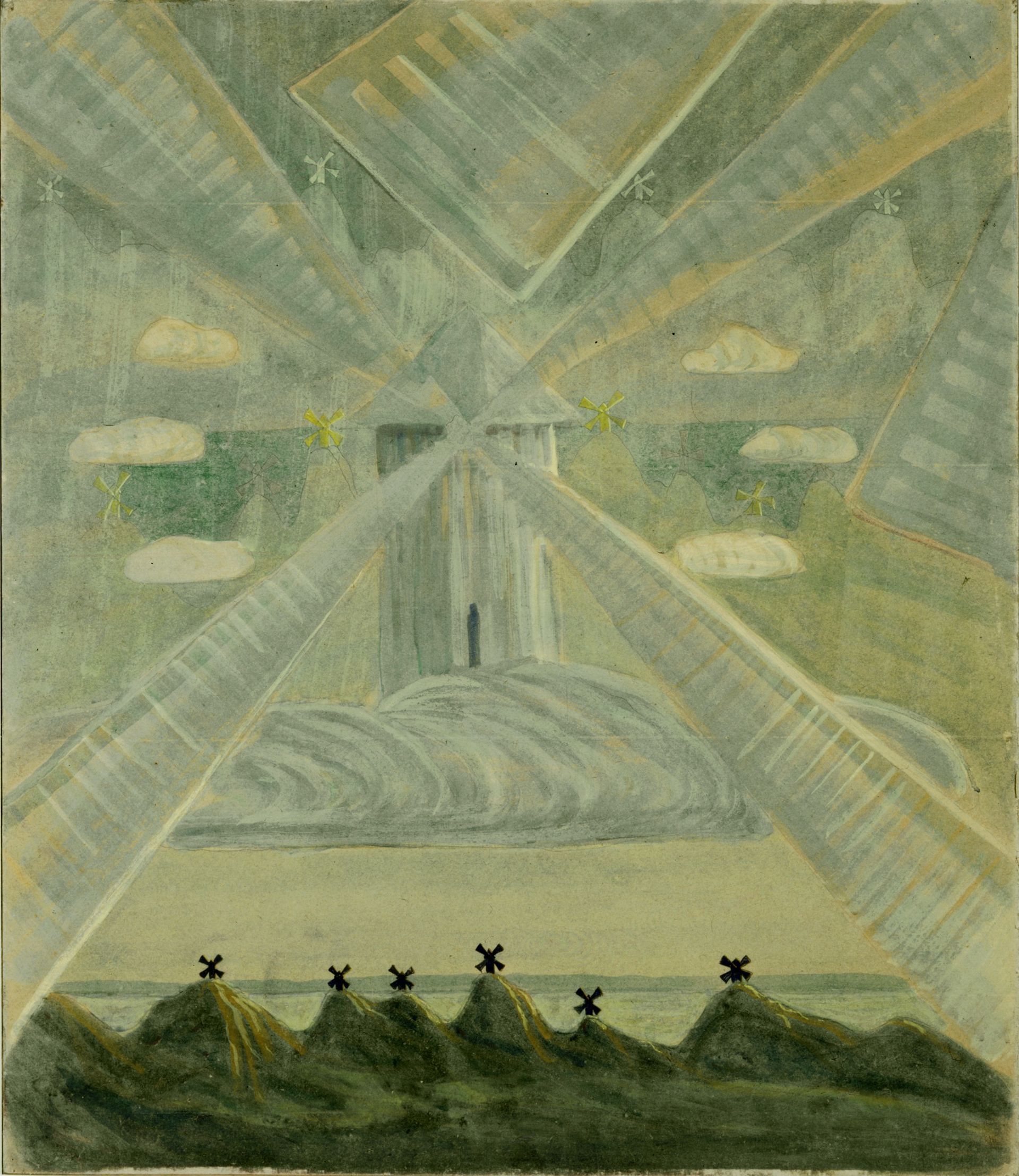
On the ground, the windmills are small, lively, realistic. In the clouds, they are huge, solemn, unreal.
MORE NOTES ON HILMA AF KLINT
The “Paintings for the Temple” series would grow to total 193 paintings in fourteen series created between 1906 and 1915, planned for a spiral-shaped sanctuary. In total, we now believe that thirteen women were involved in the creation of the Paintings for the Temple series. In her notebooks, af Klint presented Cassel as an equal partner and the others more as assistants, but the full extent of each woman’s participation remains unclear. See Klint (et al.) paintings via Wikimedia.
MORE NOTES ON THEOSOPHY
Kandinsky’s paintings were inspired by his close readings of theosophical and anthroposophical writings by Blavatsky and Steiner, and of the visual impression made by the illustrations to Annie Besant and Charles W. Ledbeater’s Thought-Forms (1905). From Theosophy Kandinsky derived his concept of vibration (he used the term Klang) – he believed that the soul is set into vibration by nature. “Words, musical tones, and colors possess the psychical power of calling forth soul vibrations” — which ultimately brings about “the attainment of knowledge.” It’s the artist’s duty to call forth soul vibrations in the viewer/audience, in order to reveal the true nature of things.

Kupka, meanwhile, trained with artists who stressed geometry rather than life drawing. He had visionary experiences — of imaginary colors, infinite space, and a constant state of flux — which he translated into visual form in his paintings.
MORE NOTES ON BERGSON
Bergson’s Creative Evolution appears in 1907, and quickly becomes the source of the “Bergson legend.” (Though Bergson was already a popular philosopher; see 1903 installment in this series.)
Bergson’s project in Creative Evolution is to offer a philosophy — a metaphysics, one appropriate for modern science — capable of accounting both for the continuity of all living beings and for the discontinuity implied in the evolutionary quality of this creation.
The real obeys a certain kind of organization, namely, that of the “qualitative multiplicity” — a temporal heterogeneity, in which “several conscious states are organized into a whole, permeate one another, [and] gradually gain a richer content.” By its very nature, our intelligence — which is adapted to the requirements of social life in general and language in particular — fails to recognize this ultimate reality.
There’s an occult aspect to this: Because a qualitative multiplicity is heterogeneous and yet interpenetrating, it is inexpressible.
The effort of intuition is what allows us to overcome the obstacles that stand in the way of true knowledge. The grasping of the processual, dynamic nature of time and matter described by Bergson requires a great effort of intuition.
How it is possible, having posited unchanging Ideas, to make change come from them? Bergson paints a picture of a kind of… semiosophere, one charged with something like dark matter, “nothing,” which creates “endless agitation.”
Beneath the changing phenomena will appear to us, by transparence, a closed system of concepts subordinated to and co-ordinated with each other… It will be prior to human knowledge… prior also to things, which awkwardly try to imitate it… Its immutability is therefore, indeed, the cause of the universal becoming.
Bergson is suspicious of systems — a system of material points artificially isolated in the continuity of nature by scientists; material systems exsected for the needs of science; a spatial move of isolating certain areas of matter in order to focus on them alone. This might seem to be an anti-structuralist argument before the advent of structuralism. And one thinks of Marinetti and the Italian Futurists’ insistence that the painting should cease to isolate certain subjects; the painting should demonstrate how that subject is interpenetrated by its context; one also thinks of Fernand Léger’s “The Wedding” (1910–1911). Arnaud François calls Bergson an “overtly anti-systematic” philosopher; that is to say, it’s more more subtle. With the pre-Socratic Greek philosophers, Bergson posits a “single, perfectly coherent system of intelligible [things / truths],” though we can only make out this system in a “blurred, obscure way.” (From a 1903-904 course on ancient philosophy given by Bergson.)
Yet Bergson also praises “philosophical” systems — the thought of a philosopher regarded as a self-sufficient whole. When science or philosophy comprehends “matter” in its entirety — this too, is a system, the good sort of system. Like any system it’s closed, but its closure is not the arbitrary decision of the scientist. Bergson speaks of “relatively closed systems” — the solar system say — which are systems embedded in other systems. We don’t “isolate” (exsect) such a system merely for convenience; nature itself invites us to isolate such a system. The major characteristic of the good kind of a system is “duration.” So Bergson isn’t perhaps anti-structuralist — like a post-structuralist, he merely seeks to ensure that structuralists don’t confuse their tidy models with reality.
The trick, for Bergson, is to identify sub-systems within the grand system (life, the universe, everything) that present a certain degree of autonomy. There exists a bond between ll systems, pulling them together, always, since ultimately they all play a role in the overall system; but “this bond may be regarded as infinitely loose in comparison with the mutual dependence which unites the parts of the same [system] among themselves.” So it becomes a matter of identifying and evaluating the strength and weakness of bonds between the elements of a system — which is what was happening in science at this time too.
This sort of system — cf the semiosphere, and see below re Saussure — is an “articulation of the real.” We can treat this articulation as a whole — this is a useful way to think of it — even while recognizing that an absolute undivided totality it most certainly is not.
See: Arnaud François’s “Reflections on the Notion of System in Creative Evolution” (in The Bergsonian Mind, ed. Mark Sinclair, Yaron Wolf).
NOTES ON SAUSSURE
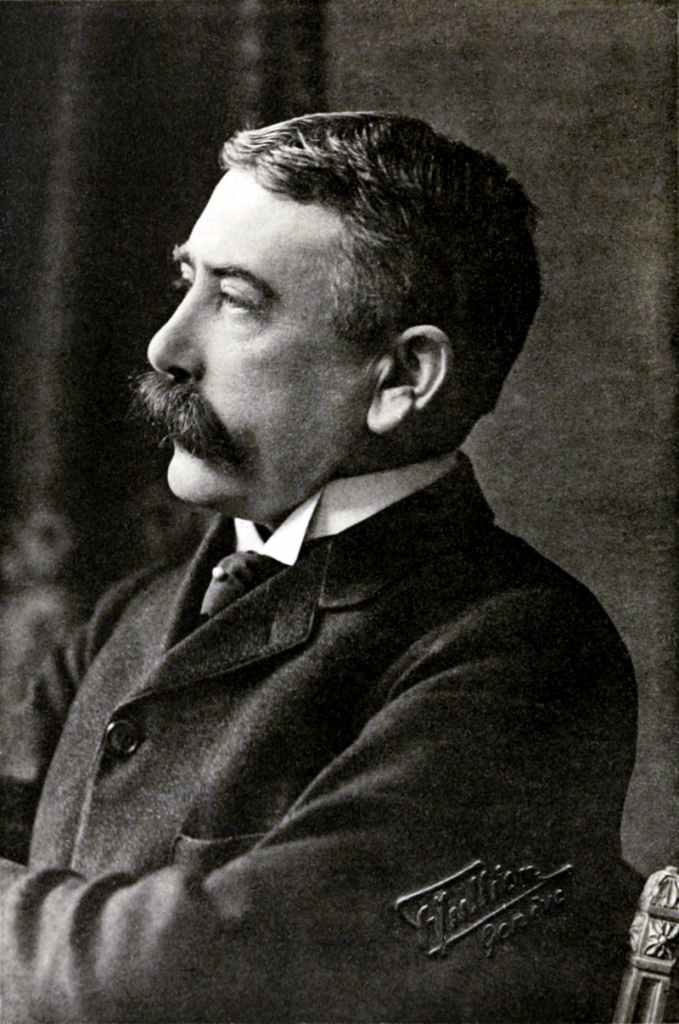
From 1907–1911, the Swiss linguist, semiotician and philosopher Ferdinand de Saussure delivered a series of lectures at the University of Geneva. These were later collected, by two of his students, as the Cours de linguistique générale, setting forth a proposed science of “semiology.” The book would become a fundamental influence on structuralism — a general theory of culture and a methodology which implies that elements of human culture can only be fully understood by way of their relationship to a broader system.
The essence of the “Saussurean revolution” in linguistics, it has been said, is that language was prescribed to be viewed not as a chaotic totality of facts but as an edifice in which all elements are bound to one another; and his theory of a two-tiered reality about language (the first is the langue, the abstract and invisible layer, while the second, the parole, refers to the actual speech that we hear in real life.) Saussure was known to attend séances and was interested in Theosophy.
Saussure’s claim that language works through relations of difference, which place signs in opposition to one another, and his emphasis on surfacing an abstract and invisible “structure” that shapes and guides our perception and behavior… “rhymes” with what esotericists of the era were exploring. Also compare the credos of abstract artists. For example, Malevich’s The Non-Objective World (1927) says, of the abstract movement he’d founded in 1913, that “To the Suprematist, the visual phenomena of the objective world are, in themselves, meaningless; the significant thing is feeling, as such, quite apart from the environment in which it is called forth.”
NOTES ON CUBISM
Cubism ushered in a definitive movement with the revelation of Picasso’s Les Demoiselles d’Avignon (1907). However, the movement did not receive its name until 1908, when, an art critic described Braque’s House at L’Estaque as being fashioned from cubes. The central aim of Cubists was to discard the mimicry of past paintings to instead highlight the flat dimensionality of the canvas. This effect was achieved through the use of various conflicting vantage points to paint pictures of common objects and the human figure. A monochromatic scale emphasized the focus on the inherent structure of these works.
NOTES ON ABSTRACT ART
Working in relative isolation — Malevich in Russia, Kandinsky in Germany, Mondrian in the Netherlands, Kupka in France — they showed inventive ingenuity in escaping from the confines of native cultural and artistic tradition to enter a world of ideas. Theosophical diagrams — which supposedly reflected an ancient wisdom at the root of all religions — were a shared inspiration.
Art not only as a vehicle of aesthetic satisfaction but also as a conduit between the microcosm of earthly existence and the macrocosm of everlasting spiritual existence. Structuralist diagrams are also a conduit between the microcosm of “signs” that express concepts and the macrocosm of the concepts in and of themselves.
Theosophists, abstract artists, Saussure too? — suggest the essence of nature is manifested as a rhythmic geometric force. Consciousness of this force is made possible by a disciplined effort as a “medium.”
Kandinsky’s paintings were inspired by his close readings of theosophical and anthroposophical writings by Blavatsky and Steiner, and of the visual impression made by the illustrations to Annie Besant and Charles W. Ledbeater’s Thought-Forms (1905). From Theosophy Kandinsky derived his concept of vibration (he used the term Klang) — he believed that the soul is set into vibration by nature. “Words, musical tones, and colors possess the psychical power of calling forth soul vibrations” — which ultimately brings about “the attainment of knowledge.” It’s the artist’s duty to call forth soul vibrations in the viewer/audience, in order to reveal the true nature of things.
I think it’s a 1937 interview where Kandinsky says: “Abstract painting leaves behind the ‘skin’ of nature, but not its laws. Let me use the ‘big words’ cosmic laws. Art can only be great if it relates directly to cosmic laws and is subordinated to them.” He and other abstract pioneers made claims to supernatural knowledge in stating that they had penetrated the outer shell of nature while still upholding the connection with the cosmos and its laws. From the point of view of epistemology, abstractionists are doing the same work as Besant and Leadbeater’s occult chemistry. Their diagrammatic paintings are counterparts to occult chemical digarams.
MORE RADIUM AGE SCI FI ON HILOBROW: RADIUM AGE SERIES from THE MIT PRESS: In-depth info on each book in the series; a sneak peek at what’s coming in the months ahead; the secret identity of the series’ advisory panel; and more. | RADIUM AGE: TIMELINE: Notes on proto-sf publications and related events from 1900–1935. | RADIUM AGE POETRY: Proto-sf and science-related poetry from 1900–1935. | RADIUM AGE 100: A list (now somewhat outdated) of Josh’s 100 favorite proto-sf novels from the genre’s emergent Radium Age | SISTERS OF THE RADIUM AGE: A resource compiled by Lisa Yaszek.
